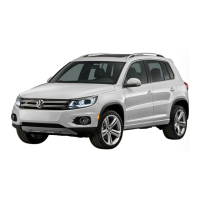P
r
o
t
e
c
t
e
d
b
y
c
o
p
y
r
i
g
h
t
.
C
o
p
y
i
n
g
f
o
r
p
r
i
v
a
t
e
o
r
c
o
m
m
e
r
c
i
a
l
p
u
r
p
o
s
e
s
,
i
n
p
a
r
t
o
r
i
n
w
h
o
l
e
,
i
s
n
o
t
p
e
r
m
i
t
t
e
d
u
n
l
e
s
s
a
u
t
h
o
r
i
s
e
d
b
y
V
o
l
k
s
w
a
g
e
n
A
G
.
V
o
l
k
s
w
a
g
e
n
A
G
d
o
e
s
n
o
t
g
u
a
r
a
n
t
e
e
o
r
a
c
c
e
p
t
a
n
y
l
i
a
b
i
l
i
t
y
w
i
t
h
r
e
s
p
e
c
t
t
o
t
h
e
c
o
r
r
e
c
t
n
e
s
s
o
f
i
n
f
o
r
m
a
t
i
o
n
i
n
t
h
i
s
d
o
c
u
m
e
n
t
.
C
o
p
y
r
i
g
h
t
b
y
V
o
l
k
s
w
a
g
e
n
A
G
.
4.8 Changing brake fluid
Instructions for use and safety ⇒ page 30
Changing brake fluid ⇒ page 30
4.8.1 Instructions for use and safety
WARNING
♦ In hybrid vehicles, the hybrid-relevant components in the
working area must be visually inspected ⇒ page 40
♦ In the event of conspicuous findings or uncertainties, con‐
tact your responsible high-voltage technician or specialist
electrician!
♦ Brake fluid must under no circumstances come into con‐
tact with fluids containing mineral oils (oil, petrol, cleaning
solutions). Mineral oils will damage seals and sleeves of
brake system.
♦ Brake fluid is poisonous. In addition, due to its corrosive
nature, it must not come into contact with paint.
♦ Brake fluid is hygroscopic, i.e. it attracts moisture from the
surrounding air and therefore must always be stored in air-
tight containers.
♦ Wash away spilt brake fluid using plenty of water.
♦ Do not reuse extracted (used) brake fluid.
♦ Observe disposal regulations!
Caution
For this vehicle only brake fluid VW 501 14 -B 000 750- must
be used.
4.8.2 Procedure, changing brake fluid
Special tools and workshop equipment required
♦ Vehicle diagnostic, testing and information system -VAS 5051-
Touareg 2010 ➤
Maintenance - Edition 11.2011
30 4. Descriptions of work

